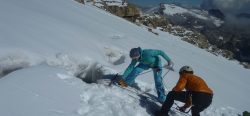STATION NAME AND OWNER
The Kolari Field Site belongs to the Natural Resources Institute Finland LUKE.
LOCATION
The Kolari Field Site is located in northwest Finland at 67° N, close to the Swedish border. The surrounding area consists of northern borealNorthern, from Boreas, the Greek god of the north wind.... More taigaBoreal forest, a nearly continuous belt of coniferous trees across North America and Eurasia. Taiga is dense forest with many fallen trees and marshy soil. The term derives form the southern Siberian Turkic-Mongol... More forests and swamps, as well as mountains up to 700 m a.s.l. Kolari village is approximately 4 km, and the Muonio River is approximately 300 meters away from the station. The Pallas-Ylläs National Park is located 30 km from station. With almost half a million annual visitors, it is Finland’s best known national park.
BIODIVERSITY AND NATURAL ENVIRONMENT
Geographically, the Kolari area is located between Northern Finland, Forest Lapland and Fell Lapland, making it a very varied and interesting habitat. Kolari is situated at the western limit of the Russian taigaBoreal forest, a nearly continuous belt of coniferous trees across North America and Eurasia. Taiga is dense forest with many fallen trees and marshy soil. The term derives form the southern Siberian Turkic-Mongol... More. The area is characterised as a mixture zone of eastern and western species of floraThe plants that live in a particular region, habitat or time (such as geological period like the jurassic). For animals, we use the term fauna, and to collectively refer to all... More and faunaThe animals that live in a particular region, habitat or time (such as geological period like the jurassic). For plants, we use the term flora, and to collectively refer to all... More and includes old pine forest, wetlands, lakes, and rivers. Bears, moose, and reindeer are found in the area. Snow covers the landscape from November to May.
HISTORY AND FACILITIES
The Kolari Field Site was established in 1964 for the study of peatPeat is a soil type formed from slowly decomposing vegetation. It is found in wet areas where the lack of oxygen slows the breakdown of plant matter. Peatlands are areas... More lands. Today we focus on sustainable use of northern timberline forests and integration of different nature-based livelihoods also with respect to rapidly growing mining activities in this area. The station has 15 offices, high speed internet, and guestrooms for visitors. Kolari village offers various services, and a broad range of outdoor activities is possible in the nearby Ylläs National Park.
GENERAL RESEARCH AND DATABASES
The research at Kolari focuses on the integration of different nature-based livelihoods at the timberline (tourism, reindeer herding, and forestry), ecologically sustainable forestry, nature protection, and plant ecologyThe study of living organisms in their environment, including where they are found and how they interact with their physical environment and with each other, for example through food webs.... More. The main objectives of the ecological projects are to study the dynamics of natural forests and disturbance dynamics of forest fires. Existing databases include a bibliography of publications arising from research at the station, as well as long term ecological data concerning timberline regeneration, rodents, seed yield, and phenologyThe study of the timing of recurring natural events such as bud opening, egg laying or the arrival of a migratory animal. Many living organisms have defined life cycle events... More. The last couple of years extensive studies of wild river salmon have been carried out here.
HUMAN DIMENSION
The nearest community is Kolari village (five km away) with approximately 1500 inhabitants. A bit larger is the Swedish Pajala (c. 6200 inhabitants) which is located 30 km from the Kolari Field Site. Most of the local people are of Finnish origin with long and strong ties to the area and also to the Sami people. The border to the Finnish Sami region is 100 km to the north but it is only two km away from the Swedish Sami region. Tourism and public services are nowadays the main economic factors, but reindeer herding still plays an important role in the area as well as other land uses like forestry and agriculture. Fishing, hunting, and recreational use of the nature are all essential parts of the local culture and provide great opportunities for various outdoor activities.
ACCESS
You can reach Kolari Field Site easily by car, train or airplane. We are located along Highway 21 from Tornio to Kilpisjärvi. The railway station is less than one km away. Nearest airport is Kittilä Airport 75 km from the station.





















